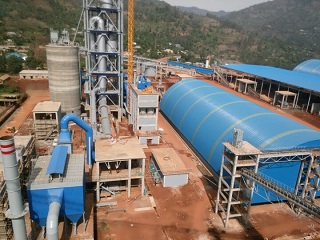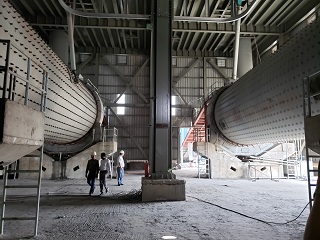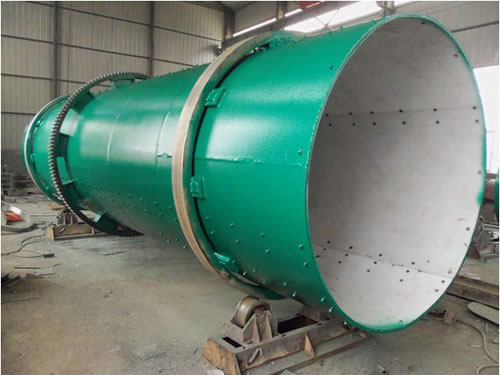Product introduction
The 2500t / d cement clinker production line adopts a new dry process, with an annual output of 775,000 tons of cement clinker and a total cement output of 1.05 million tons / year. A cement production line and auxiliary facilities from limestone crushing to cement packaging are constructed. Specialties include raw materials, production technology, electrical and automation, water supply and drainage, HVAC fire protection, building structure, environmental protection, etc. Cement products are calibrated according to Chinese standard ordinary portland cement.
Process parameters
(1)Clinker output: ≥ 2500 t / D;
(2) clinker burning heat consumption
(3) clinker comprehensive power consumption
(4) cement comprehensive power consumption
(5) clinker 28 day strength
(6) dust emission concentration
Production process
In cement production, limestone and clay are used as main raw materials, which are crushed, proportioned and grinded into raw materials by vertical mill, then fed into cement rotary kiln to calcine mature materials, and then the clinker is added with appropriate amount of gypsum, mixed with some mixed materials or additives, grinded into cement by cement grinding, and transported out of the factory by packaging machine or bulk machine. The cement production equipment adopts the dry process cement production process. After the raw materials are dried and ground into raw meal powder, they are fed into the dry process rotary kiln to calcine into clinker. The main advantage of dry process production is low heat consumption.
Main equipment list
NO.
|
Specification
|
Quantity
|
|
G01/01
|
Heavy apron-feeder
|
1
|
|
G01/03
|
Hammer crusher (right-installed)
|
1
|
|
|
Model:2PCD1820
|
|
|
G04/05
|
Raw material vertical roller mill
|
1
|
|
|
Model:PFRM3841
|
|
|
|
Capacity:≥210t/h(late period of wearing)
|
|
|
|
Feeding granularity:≤80mm
|
|
|
|
Diameter of grinding table:3800mm
|
|
|
|
Quantity of rollers:4
|
|
|
G04/05-1
|
Separator
|
1
|
|
|
Size:Φ4000×2040
|
|
|
G08/01
|
Rotary kiln
|
1
|
|
|
Size:Φ4.2×60 m
|
|
|
|
Capacity:2500 t/d
|
|
|
|
Shell inclination:4.0% (sin.)
|
|
|
|
Rotating speed of shell:
|
|
|
|
Main driving: 0.4 ~4 r/min
|
|
|
|
Auxiliary driving: 7.93 r/h
|
|
|
|
Cooling water consumption:3×4 m3/h
|
|
|
G09/01
|
Kiln hood
|
1
|
|
G09/02
|
Coal powder burner
|
1
|
|
|
Model:NJ-8 four channel
|
|
|
G09/04
|
LBT27 grate cooler
|
1
|
|
|
Size:3.2×24.3m
|
|
|
|
Capacity:2700t/d
|
|
|
|
Discharging granularity:<25mm
|
|
|
|
Feeding temperature:1371℃
|
|
|
|
Discharging temperature:65℃+ ambient temperature
|
|
|
|
Effective area of grate bed:74m2
|
|
|
|
Stroke of grate bed:130mm
|
|
|
|
Times of strokes:4~20time/min
|
|
|
G09/04-1
|
Clinker crusher
|
1
|
|
|
Size:φ920×2800mm
|
|
|
|
Capacity:120t/h
|
|
|
|
Rotating speed of rotor:395r/min
|
|
|
G13/06
|
Air-swept coal mill
|
1
|
|
|
Size :3.2X(6.5+2.5)
|
|
|
|
Chambers:2
|
|
|
|
Feeding granularity(mm):
|
|
|
|
≤25(95% passing)
|
|
|
|
Moisture content of coal powder :≤1%
|
|
|
|
Finess of discharged finished product :3~5% residue on 80μm sieve
|
|
|
|
Inlet moisture content:≤12%
|
|
|
|
Inlet air temperature : 300 (Max.400)℃
|
|
|
|
Outlet air temperature :60-80℃
|
|
|
|
Capacity:20~22t/h
|
|
|
G15/06
|
Packer
|
2
|
|
|
Model:BHYW(ZN)-8 D
|
|
|
|
Capacity:110 t/h
|
|
|
|
Tolerance of single bag:50+0.6kg -0.2kg
|
|
|
G14c/01
|
Cement mill
|
1
|
|
Size:Φ3.2×15m
|
|
|
Capacity:60t/h
|
|
|
Process description
1)The limestone is poured into the hopper by the limestone crushing dump truck. After being crushed by the hammer crusher, it is sent to the limestone pre homogenization yard by the belt conveyor. The cantilever stacker is used for layered stacking and reclaiming. The limestone taken out is sent to limestone batching bin of raw material batching station by belt conveyor. An electromagnetic iron remover is arranged on the warehousing belt conveyor to remove the possible iron parts in limestone. The head of the belt conveyor is equipped with a metal detector to detect whether there are iron parts left in the raw materials, so as to avoid damage to the raw material grinding roller press. The raw material batching station is equipped with limestone, clay and other batching bins. The bottom of each batching bin is provided with a plate feeder and a constant feeder. The four kinds of raw materials are discharged by their respective constant feeder according to the proportion required by batching, and the mixture is fed into the raw material vertical mill through a belt conveyor.
2)The vertical roller mill system is adopted for raw material grinding, and the high temperature waste gas discharged from the kiln tail is used as the drying heat source. After the materials are milled by vertical mill, they are dried and graded by V-type powder concentrator. After the fine powder is selected by high-efficiency powder concentrator, part of the fine powder is sent to raw material homogenization warehouse by air conveying chute and bucket elevator.
3)The coal mill is set at the end of the kiln. Part of the waste gas from the end of the kiln is used as the drying heat source of the raw coal after being collected by the cyclone. After humidification and cooling of kiln tail gas by humidification tower, it will directly enter into the electric dust collector at kiln tail. The water spray volume of humidification tower will be automatically controlled according to the temperature of waste gas at the outlet of humidification tower, so that the temperature of waste gas is within the allowable range of electric dust collector at kiln tail. The purified waste gas of dust collector will be discharged into the atmosphere by exhaust fan. The kiln ash collected by the humidification tower is sent to the kiln feeding system or raw meal homogenization silo through the conveying equipment. A continuous raw meal homogenization silo is set up. The raw meal in the silo is discharged to the mixing chamber from the surrounding ring area after being inflated alternately and evenly in the mixing chamber. The required bottom inflation is supplied by the configured roots blower. After being measured, the homogenized raw meal is conveyed to the inclined trough and bucket elevator by air, and then fed to the two feed ports of the double series preheater respectively by the distributing valve and the air lock valve.
4)The firing workshop is composed of five-stage double series suspension preheater, decomposing furnace, rotary kiln, grate cooler and corresponding dedusting system, with a daily output of 2500t cement clinker. The raw material fed into the preheater is preheated by the preheater and decomposed in the decomposing furnace, and then fed into the kiln for calcination; the high-temperature clinker out of the kiln is cooled in the grate cooler, and the large clinker is crushed by the crusher, and then collected together with the small clinker leaked under the air chamber, and then sent to the clinker warehouse for storage by the clinker chain bucket conveyor. In addition to providing high temperature secondary air and tertiary air to the kiln and decomposition furnace respectively, the hot air through the clinker bed is discharged into the atmosphere by the exhaust fan after being purified by the electric dust collector. After the clinker is unloaded by the unloading device at the bottom of the silo, it is sent to the bulk truck station by the belt conveyor, and the bulk clinker is directly loaded by the dust-free bulk head at the bottom of each silo.
5)The pulverizing system is adopted for the preparation of pulverized coal, and the high temperature waste gas discharged from the kiln tail is used as the drying heat source. The raw coal is fed into the coal mill by the quantitative feeder under the raw coal bunker for drying and grinding. The pulverized coal out of the mill enters the bag type dust collector along with the air flow. The qualified pulverized coal is collected and sent to the pulverized coal bunker with the load sensor by the screw conveyor. The pulverized coal is metered and sent to the burner at the kiln head and the decomposing furnace at the kiln tail for combustion. The dust containing gas is purified by the anti-static bag dust collector and then discharged into the atmosphere by the exhaust fan. The coal bunker and bag type dust collector are equipped with CO detector device and explosion-proof valve. A central laboratory is set up in the whole plant to be responsible for the inspection of raw fuel, semi-finished products and finished products; and an air compressor station is set up to supply compressed air for the production of the whole plant.
6)The grinding head bin is used for cement batching, the φ 3.2 × 13m cement mill is selected for the mill, and the roller press is matched according to the situation to achieve the cement output of 180 t / h. The finished cement is pneumatically delivered to the original cement warehouse by the double bin pump. There are four φ 12 × 42m round warehouses for cement storage, with a total storage capacity of 20000T and a storage period of 4.6d. The finished cement products from the cement grinding system are pneumatically delivered to the cement storage system. The cement silo is equipped with a unloading and decompression cone-shaped chamber and an inflation device. The air source for inflation is provided by roots blower. The cement packaging workshop is equipped with two eight mouth rotary packaging machines with a single output of 90-100t / h.







